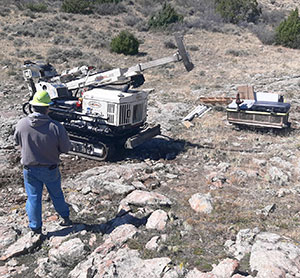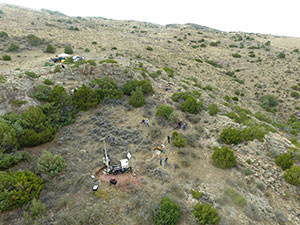
Contact Us
Institutional Communications
Bureau of Mines Building, Room 137
Laramie, WY 82071
Phone: (307) 766-2929
Email: cbaldwin@uwyo.edu
UWs Carr Helps Casper College Professor Drill Down on Douglas Crater Theories
Published November 14, 2022

Bradley Carr, an associate research scientist in the University of Wyoming Department
of Geology and Geophysics, maneuvers UW’s Geoprobe drill rig at the first coring site
at the edge of an impact crater -- known as George’s Crater -- outside of Douglas
near Sheep Mountain. Carr recently assisted Kent Sundell, a geology instructor in
Casper College’s School of Science, with his research. (Kent Sundell Photo)
The best science is often done in collaboration, when researchers with different specialties bring their skills together to tackle probing questions.
This happened recently, when Bradley Carr, an associate research scientist in the University of Wyoming Department of Geology and Geophysics, worked with Kent Sundell, a geology instructor in Casper College’s School of Science, at an impact crater -- known as Sheep Mountain Crater No. 1 (SM-1) or George’s Crater -- outside of Douglas near Sheep Mountain.
Sundell is attempting to determine whether layering of craters in and around George’s Crater formed as part of a long-term event in which several meteorites entered Earth’s atmosphere at different times rather than simultaneously.
“I have observed -- in several sites in the Shirley Basin -- where impact-deformed rocks appear to occur interbedded with undeformed sandstones. It is my interpretation of such layering (a hypothesis) that would suggest it was a long-lived event with years or possibly thousands of years between impacts,” Sundell explains. “If so, the Douglas Impact event was not a single object that entered Earth’s atmosphere and then broke up or impacted, which caused many secondary impacts. It would have been a meteorite storm of many meteorites entering at different times caused by a larger event in our solar system -- possibly, an exploded moon or small planet.”
The Douglas Impact crater-strewn field is at the Pennsylvanian-Permian boundary on the geologic timescale at approximately 280 million years ago. More than 40 circular-to-ellipsoidal possible impact structures have been identified on the northeast flank of the Sheep Mountain anticline, according to a paper co-written by Sundell that was published in Scientific Reports in 2018.
Sundell adds an alternative hypothesis would be that a single impact could inject deformed rocks in between the undeformed layers.
“We are currently sampling and continuing to test both hypotheses to see which is correct,” Sundell says.
Carr, director of UW’s Near-Surface Geophysics Instrument Center (UWNSG) and facility manager for the Wyoming Center for Environmental Hydrology and Geophysics, handled geophysical, drilling and sampling components for Sundell’s work.
“During this project, we were simply trying to collect in situ rock cores for geochemical analyses within known impact structures,” Carr says.
Drilling, or coring, at the George’s Crater site -- named after the deceased family patriarch of a ranching family that owns the surface land rights -- took place Sept. 22-Oct. 2. Coring means drilling and collecting samples of the strata every 4 feet for each hole made, Carr says. Strata is a layer or series of layers of rock in the ground. In total, core samples were collected from four boreholes.

This overhead view shows the UW Geoprobe drill rig inside George’s Crater, set up
and ready to begin coring the next day. The trucks and pop-up tent -- located to the
left and higher up behind the crater’s edge -- are where Kent Sundell and his Casper
College research team cataloged and processed the rock cores. Sundell is attempting
to determine whether layering of craters in and around George’s Crater formed as part
of a long-term event in which several meteorites entered Earth’s atmosphere at different
times rather than simultaneously. (Kent Sundell Photo)
“The recovery was 125 feet of core. Of the four boreholes, two boreholes were the principal target holes for Dr. Sundell,” Carr says. “The first was the crater rim hole, where we recovered 89 feet of core. The second was in the middle of the crater, where we recovered 25 feet of core. The remaining 11 feet were drilled outside of the crater but were abandoned due to a loss of drilling fluid, or water, circulation.”
Sundell stresses his research group, as of yet, has not precisely dated any of the core samples from the crater impact sites. However, he and the other researchers will look for platinum group minerals -- including platinum, palladium, iridium, osmium, rhodium and ruthenium -- that have similar chemical properties and are commonly associated with iron-rich meteorites.
“These minerals are very rare in rocks in Earth’s crust but are more common in meteorites, which are usually 99 percent iron but may contain some or all of these rare elements,” Sundell says.
Since the drilling work finished, Sundell’s Casper College students have been mapping and sampling more possible craters along the east flank of Sheep Mountain.
“We continue to see new possible crater sites on Google Earth and with drones in the field,” Sundell says. “Then, we must map them and sample to test for shocked quartz, which verifies that they are impact-related.”
Sundell says his group just sampled impact craters SM-59 and SM-61 and will send the samples to Germany, where Thomas Kenkmann, a professor and head of the Institute of Earth and Environmental Sciences at the Albert Ludwig University of Freiburg in Breisgau, Germany, will verify whether the core samples contain shocked quartz.
“Establishing whether any of these rare elements are in the Douglas Impact event at George’s Crater could help us find more impact sites throughout Wyoming, and possibly the world, in trying to establish exactly how big this event may have been,” Sundell says.
Over the past eight years, the UWNSG and the UW Department of Geology and Geophysics have supported Sundell on a variety of research projects that involve the use of geophysics equipment.
“I will continue to be involved with this project as a collaborator to Dr. Sundell,” Carr says. “This could involve data reduction of existing geophysical data or any future geophysical data acquisition. Additionally, the UWNSG drilling and coring capability is available to continue any sampling if needed by Dr. Sundell.”
As more data are gathered, Sundell says that information could change the group’s interpretations.
“The drill cores will truly test a lot of ideas about these craters and their bolides and possibly change our earlier interpretations,” Sundell says.
Contact Us
Institutional Communications
Bureau of Mines Building, Room 137
Laramie, WY 82071
Phone: (307) 766-2929
Email: cbaldwin@uwyo.edu
